 |
|
|
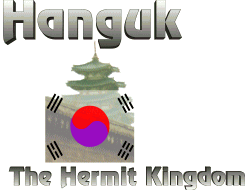

The close geographic proximity of the Japanese, Koreans, and Chinese has created the strongest basis for claims of racial and cultural relatedness. Many Chinese believe the Japanese were originally Chinese, many Koreans believe that the Japanese that dominate the islands today are descendants of Koreans, while the Japanese claim that the Koreans have descended from the population on the Japanese islands and have used this claim as a basis for colonial control of the peninsula. The name of the Korean people, Han, (Both Korea's Korean name, Hanguk, and its language, Hangul, are derived from the name of its people as well) is the same as the name of the vast majority of the people of China but the written character is different. Even one of the most common surnames in Korea, Lee, is also one of the most common names in China(another common Korean name, Kim, is unique to Korea [correction here]). The Koreans adopted Chinese characters before the
Korean alphabet was developed so it is possible that the written distinction for Han symbolized a differentiation between
the two peoples that developed sometime before the Chinese system of writing was adopted by the Koreans.
Apart from the impressive architectural sites dating from the Choson Period found in Seoul, equally impressive is
the sculpture to Admiral Yi Sun-shin and a monument at Tapgol Park (Pagoda Park).
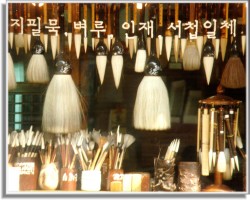 The Admiral Yi Sun-shin
monument is located at the intersection of the two most important streets in central Seoul,
Sejongno (named after the Sejongno the Great, fourth monarch of the Choson Dynasty)
and Chongno. Admiral Yi Sun-shin was the Choson leader who defeated the invading Japanese forces
of Hideyoshi with his iron clad "turtle boats" in the sixteenth century. Korea was annexed by
Japan in 1910. Tapgol Park was the site of a popular uprising against the annexation, known as the
March 1st Independence Movement (which incidentally lays claim to having influenced the more famous Chinese
May 4th Movement which was held two months later that same year). The March 1st Movement occurred on that date in 1919 when a declaration of independence was
read at the park in the hope of gaining international support - particularly the United States' because the wording of the Versailles Treaty made many believe that Woodrow Wilson was supportive of the independence of states such as Korea's. A portion of the remarkable independence text which is engraved in its entirety at the park reads as follows: The Admiral Yi Sun-shin
monument is located at the intersection of the two most important streets in central Seoul,
Sejongno (named after the Sejongno the Great, fourth monarch of the Choson Dynasty)
and Chongno. Admiral Yi Sun-shin was the Choson leader who defeated the invading Japanese forces
of Hideyoshi with his iron clad "turtle boats" in the sixteenth century. Korea was annexed by
Japan in 1910. Tapgol Park was the site of a popular uprising against the annexation, known as the
March 1st Independence Movement (which incidentally lays claim to having influenced the more famous Chinese
May 4th Movement which was held two months later that same year). The March 1st Movement occurred on that date in 1919 when a declaration of independence was
read at the park in the hope of gaining international support - particularly the United States' because the wording of the Versailles Treaty made many believe that Woodrow Wilson was supportive of the independence of states such as Korea's. A portion of the remarkable independence text which is engraved in its entirety at the park reads as follows:
"WE HAVE NO DESIRE TO ACCUSE JAPAN OF BREAKING MANY SOLEMN TREATIES SINCE 1636 NOR TO SINGLE OUT TEACHERS IN THE SCHOOLS OR GOVERNMENT OFFICIALS WHO TREAT THE HERITAGE OF OUR ANCESTORS AS A COLONY OF THEIR OWN AND OUR PEOPLE AND THEIR CIVILIZATION AS A NATION OF SAVAGES, FINDING DELIGHT ONLY IN BEATING US DOWN AND BRINGING US UNDER THEIR HEEL.
"...WE HAVE NO WISH TO FIND SPECIAL FAULT WITH JAPAN'S LACK OF FAIRNESS OR HER CONTEMPT OF OUR CIVILIZATION AND THE PRINCIPLES OF WHICH HER STATE RESTS; WE WHO HAVE GREATER CAUSE TO REPRIMAND OURSELVES, NEED NOT SPEND PRECIOUS TIME FINDING FAULT WITH OTHERS. NEITHER NEED WE, WHO REQUIRES SO URGENTLY TO BUILD FOR THE FUTURE, SPEND USELESS HOURS OVER WHAT IS PAST AND GONE, OUR URGENT NEED TO-DAY IS THE SETTING UP OF THE HOUSE OF OURS AND NOT A DISCUSSION OF WHO HAS BROKEN IT DOWN, OR WHAT HAS CAUSED ITS RUIN. OUR WORK IS TO CLEAR THE FUTURE OF DEFECTS IN ACCORD WITH THE EARNEST DICTATES OF CONSCIENCE. LET US NOT BE FILLED WITH BITTERNESS OR RESENTMENT OVER PAST AGONIES OR PAST OCCASIONS FOR ANGER.
"...THE RESULT OF ANNEXATION, BROUGHT ABOUT WITHOUT ANY CONFERENCE WITH THE KOREAN PEOPLE, IS THAT THE JAPANESE, INDIFFERENT TO US, USE EVERY KIND OF PARTIALITY FOR THEIR OWN, AND BY A FALSE SET OF FIGURES SHOW A PROFIT AND LOSS ACCOUNT BETWEEN US TWO PEOPLES MOST UNTRUE, DIGGING A TRENCH OF EVERLASTING RESENTMENT EVER DEEPER THE FARTHER THEY GO.
"...TO BIND BY FORCE TWENTY MILLIONS OF RESENTFUL KOREANS WILL MEAN NOT ONLY LOSS OF PEACE FOREVER FOR THIS PART OF THE FAR EAST, BUT ALSO WILL INCREASE THE EVER-GROWING SUSPICION OF FOUR HUNDRED MILLIONS
OF CHINESE UPON WHOM DEPENDS THE DANGER OR SAFETY OF THE FAR EAST BESIDES STRENGTHENING THE HATRED OF JAPAN. FROM THIS ALL THE REST OF THE EAST WILL SUFFER. TO-DAY KOREAN INDEPENDENCE WILL MEAN NOT ONLY DAILY LIFE AND HAPPINESS FOR US, BUT ALSO IT WOULD MEAN JAPAN'S DEPARTURE FROM AN EVIL WAY AND EXALTATION TO THE PLACE OF TRUE PROTECTOR OF THE EAST. SO THAT CHINA, TOO, EVEN IN HER DREAMS WOULD PUT ALL FEAR OF JAPAN ASIDE. THIS THOUGHT COMES FROM NO MINOR RESENTMENT, BUT FROM A LARGE HOPE FOR THE FUTURE WELFARE AND LESSING OF MANKIND..."
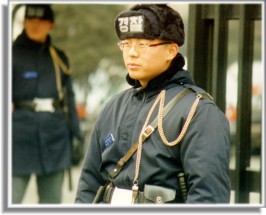 guard infront of the Government Complex in Sejongno.
guard infront of the Government Complex in Sejongno.

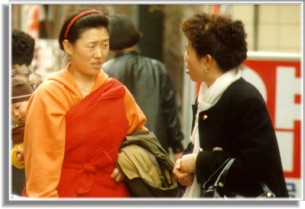
From the time Korea regained its independence after World War II and the peninsula was subsequently split into North and South, South Korea had been ruled primarily by dictators though a transition since the 1980's to what scholars call civil society where democracy has taken place. One form that this transition has taken is mass student and labor protests which are either contained or crushed. We saw the force that is used against such protests around Kyongbokkung. They are called "combat police" and look to be no older than the college students they are so often called out to do battle with.
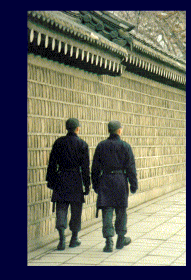 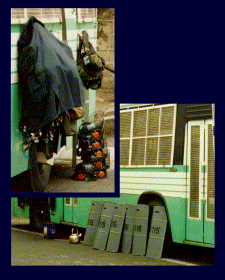 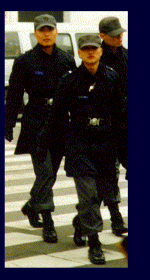
Korea, well not as affluent as Japan, looked very prosperous. The subway system operating in Seoul was very fast and efficient. The markets were thriving and you could purchase almost anything from pigs feet and heads to Korean electronic goods at a fraction of the cost of Japanese electronic goods. The prices for goods were relatively high (compared to Thailand and the Philippines though somewhat cheaper than in the U.S.), but it was evident that Korea still had import restrictions on goods. One clear example of this was the lack of variety of cars we saw in Korea. From a Seoul sidewalk the cars which drove by invariably bore Korean manufacturer names like Kia, Asia, Hyundai, Ssangyong, and Daewoo.
Energy consumption in Korea seemed also to be underdeveloped. We saw people using cylindrical coal bricks to heat seats, water, and space throughout Korea and it was likely that this form of energy was a large contributor to the heavily polluted air.
We were perplexed by certain aspects of Korean society. I couldn't understand why people drove their cars on the right-hand side of the rode, but seemed to walk on the left-hand side of walkways. Another, less benign problem, was that the subway maps did not all have the same orientation, so that one stop might be on the bottom of a map and on another map detailing the same area it may be on the top (so that the North and South directions were different on the two maps) making travelling by subway very confusing at times. We were also frustrated by the fact that people in Seoul, in particular, often seemed to be in a hurry and being bumped by somebody hurrying past you was all too common. It was all the more frustrating because if you kept your eyes on any one individual it didn't look as if they had any reason to be in a hurry. It was just their normal walking pace.
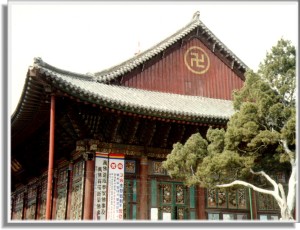 Chogyesa Temple, Seoul
Chogyesa Temple, Seoul
It may be that Korea, Japan, and China all have practitioners of Confucianism and Buddhism, but Korean culture is as different from Chinese culture and Japanese culture as can possibly be imagined. Two aspects of Korean culinary culture exemplify this fact. Koreans eat with metal chopsticks, but use metal spoons to eat soup and rice. It is also considered rude to lift the bowl from which you eat noodles or rice from. Japanese and Chinese people use chopsticks for rice and the accompanying food, these chopsticks are typically made from wood or plastic, and they normally will lift up their bowls of rice or noodles whenever they find it functional. Koreans also have a unique food, kimchi (spiced cabbage), that is second only to rice in importance to their diet. At a particular time of year, kimchi is made throughout Korea in huge batches that are supposed to last for several months. We saw large pots for storing kimchi on some roofs in Seoul.
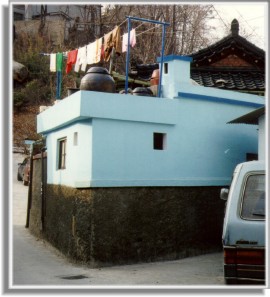 kimchi pot on rooftop in Seoul
kimchi pot on rooftop in Seoul

The South Korean government relies heavily on the U.S. military to maintain security of the nation against any threat from the North. Much of South Korea's younger generation would like nothing more than for the U.S. to vacate its bases in Korea. It is not too difficult to understand the position of those who, threat from North Korea aside, want the U.S. out of Korea simply as a matter of nationalism. When we turned on the television in Seoul there were a handful of stations, and of the maybe three that had good reception one was a U.S. military broadcast station. I also saw a military vehicle driving through the streets of Seoul and it was the only one to disregard the signals though it did not appear that it was being used for an emergency. We read an article in an English language Seoul newspaper that revealed how a Korean mother and daughter were held against their will, interrogated, and beaten by U.S. military police who believed they were smuggling military groceries out of a U.S. camp. They were released without any charge and the two women later went before the Korean authorities to complain about their ordeal. It was only after the Korean authorities interceded that the military authorities apologized to the two women. We also learned from our American authored guidebook that Americans were expected to confine their nighttime entertainment activities, illicit and otherwise, to Itaewon, the section of Seoul where the U.S. military base is located, because Americans are resented outside this de-facto American zone.
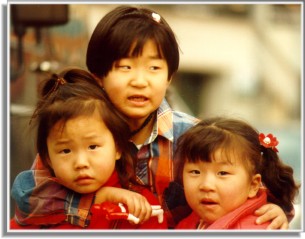 three girls near Insa-dong, Seoul
three girls near Insa-dong, Seoul
Cyber-Gallery of South Korea:
|
| |
|
PAGE BACK | COMMENTS
Learn more about Korea:
- Asia's Next Giant,
Alice H. Amsden, © 1989, Oxford University Press.
- Genre Pictures of Korea, Volumes 1 and 2,
Kim Yong Hwan, © 1990.
- Guide to Korean Culture,
Tae-Hung Ha, © 1985, Yonsei University Press.
- Introduction to Korean History and Culture, Andrew C. Nahm, © 1993, Hollym Corporation.
- Japan and Korea, The Political Dimension,
Chong-Sik Lee, © 1985, The Hoover Institution, Stanford University.
- Korea, And Introduction,
James Hoare and Susan Pares, © 1991, Kegan Paul International.
- The Koreans, Contemporary Politics and Society,
Donald Stone MacDonald, © 1990, Westview Press.
- Sourcebook of Korean Civilization, Volume 1: From Early Times to the Sixteenth Century,
edited by Peter H. Lee, © 1993, Columbia University Press.
|
| |
|
|
| |
 |
|

